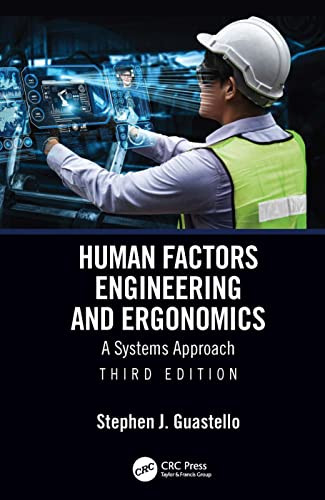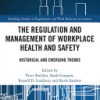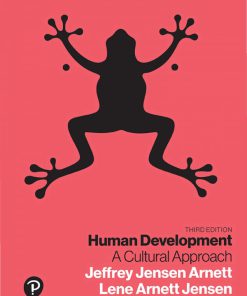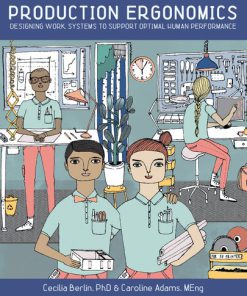Human Factors Engineering and Ergonomics: A Systems Approach 3rd Edition by Guastello 9781000822052 1000822052
$50.00 Original price was: $50.00.$25.00Current price is: $25.00.
Human Factors Engineering and Ergonomics: A Systems Approach 3rd Edition Guastello – Ebook Instant Download/Delivery ISBN(s): 9781000822052, 1000822052
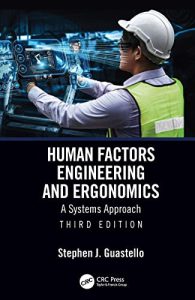
Product details:
- ISBN 10:1000822052
- ISBN 13:9781000822052
- Author: Guastello
Human Factors Engineering and Ergonomics
A Systems Approach
Table contents:
Chapter 1 Introduction to human factors and ergonomics
1.1 EVOLUTION OF PERSON–MACHINE SYSTEMS
1.2 THE ROLE OF HUMAN FACTORS AND ERGONOMICS
1.2.1 The person–machine system
1.2.2 The cognitive core
1.2.3 The workspace shell
1.2.4 Computers
1.2.5 Beyond the great outdoors
1.3 CRITERIA OF HUMAN FACTORS
1.3.1 Performance criteria
1.3.2 Industry standards
1.3.3 Civil liability
DISCUSSION QUESTIONS
Chapter 2 Elements of human factors analysis
2.1 ALLOCATION OF FUNCTION
2.1.1 The benefits of machines
2.1.2 The user population
2.1.3 Experts and novices
2.1.4 Workload issues
2.1.5 Flexible allocation of function
2.1.6 Trust in automation
2.2 HUMAN ERROR AND SYSTEM RELIABILITY
2.2.1 Error probability
2.2.2 Redundancy
2.3 USABILITY TESTING
2.3.1 Preparation
2.3.2 Iterative laboratory testing
2.3.3 Field testing
2.3.4 Technical manuals
2.3.5 Cost–benefit analysis
2.3.6 System reengineering
DISCUSSION QUESTIONS
Chapter 3 Systems change over time
3.1 COMMUNICATION, INFORMATION, AND ENTROPY
3.1.1 Communication model
3.1.2 Quantifying information
3.1.3 Entropy
3.2 HOW SYSTEM EVENTS CHANGE OVER TIME
3.2.1 Perception of change
3.2.2 What is random?
3.2.3 Simple attractors
3.2.4 Bifurcation
3.2.5 Chaos
3.2.6 Fractals
3.2.7 Self-organization
3.2.8 Catastrophes
3.2.9 Emergent phenomena
3.2.10 Synchronicity
3.3 NETWORKS
3.3.1 Social networks
3.3.2 Nonhierarchical structures
3.3.3 Centrality
3.3.4 Small worlds
3.4 SIMULATION STRATEGIES FOR COMPLEX SYSTEMS
3.4.1 Classical system simulations
3.4.2 Artificial life simulations
DISCUSSION QUESTIONS
Chapter 4 Psychophysics
4.1 CLASSICAL PSYCHOPHYSICS
4.1.1 Threshold concepts
4.1.2 Fundamental laws
4.2 SCALING PROCEDURES
4.2.1 Psychophysical stimuli
4.2.2 Non-psychophysical stimuli
4.3 SIGNAL DETECTION THEORY
4.3.1 Threshold concepts
4.3.2 Discrimination index
4.3.3 Minimization of errors
4.3.4 ROC curves
4.3.5 Individual differences
4.3.6 Power law
4.3.7 Decisions revisited
4.3.8 Predictive power
4.4 FUZZY SIGNAL DETECTION THEORY
4.5 VIGILANCE
4.6 MULTIDIMENSIONAL STIMULI
4.6.1 Multidimensional scaling
4.6.2 Multidimensional nonlinear psychophysics
4.6.3 Chaos and vigilance
DISCUSSION QUESTIONS
Chapter 5 Visual displays
5.1 THE SENSE OF VISION
5.1.1 Visual acuity
5.1.2 Color vision
5.1.3 Color vision abnormalities
5.1.4 Photopic and scotopic functions
5.2 PERCEPTION
5.2.1 Gestalt principles of form
5.2.2 Depth
5.2.3 Motion
5.3 PRINCIPLES OF DISPLAY DESIGN
5.3.1 Types of basic displays
5.3.2 Display design criteria
5.3.3 Visibility
5.3.4 Distinguishability
5.3.5 Interpretability
5.3.6 Completeness
5.3.7 Parallax effect
5.3.8 Color and contrast
5.3.9 Historical displays
5.3.10 Predictive displays
5.3.11 3-D displays
5.3.12 Digital versus analog displays
5.4 HEADS-UP DISPLAYS
5.4.1 Clutter
5.4.2 Design interactions
5.5 ICONIC DISPLAYS
5.5.1 Symbolic versus concrete pictograms
5.5.2 Emergent meaning
5.5.3 Shared meaning
5.6 DISPLAY PANEL ORGANIZATION
5.6.1 Linking analysis
5.6.2 Ecological interface design
5.7 SIGNS OF IMPORTANCE
5.7.1 Design
5.7.2 Standards
5.7.3 Behavioral impact
5.8 ILLUMINATION AND GLARE
5.8.1 Illumination
5.8.2 Glare
DISCUSSION QUESTIONS
Chapter 6 Auditory and tactile displays
6.1 SENSE OF HEARING
6.1.1 Loudness
6.1.2 Pitch
6.1.3 Timbre
6.1.4 Binaural hearing
6.2 NONVERBAL AUDITORY DISPLAYS
6.2.1 Types of nonverbal auditory displays
6.2.2 Gestalt laws of perception
6.2.3 Streaming
6.3 CLASSIC PROBLEMS AND SOLUTIONS
6.3.1 Localization
6.3.2 Confusability
6.3.3 Desensitization
6.3.4 Recommendations
6.3.5 Adding redundancy
6.3.6 3-D auditory displays
6.4 AUDITORY ICONS
6.5 SPEECH DISPLAYS
6.5.1 Speech spectrograms
6.6 NOISE
6.6.1 Colors of noise
6.6.2 More signal detection
6.6.3 Hearing loss and noise exposure
6.7 TACTILE DISPLAYS
6.7.1 Haptic perception
6.7.2 Knobs
6.7.3 Vibratotactile displays
6.7.4 Tactons
6.7.5 Gloves
DISCUSSION QUESTIONS
Chapter 7 Cognition
7.1 ORGANIZATION OF HUMAN MEMORY
7.1.1 Short-term memory
7.1.2 Long-term memory
7.1.3 Types of memory
7.1.4 Working memory
7.1.5 Attention and perception
7.1.6 Attention tunneling
7.1.7 Task switching
7.1.8 Fluid intelligence
7.2 TYPES OF DECISIONS
7.2.1 Simple binary decisions
7.2.2 Optimizing decisions
7.2.3 Nonoptimization decisions
7.2.4 Production paradox
7.2.5 Troubleshooting
7.3 COGNITIVE WORKLOAD
7.3.1 Channels and stages
7.3.2 Limited capacity theory
7.3.3 Variable capacity theory
7.3.4 Resource competition model
7.3.5 Attentional blink
7.3.6 Multitasking
7.4 MEASUREMENT OF COGNITIVE WORKLOAD
7.4.1 Behavioral indicators
7.4.2 Subjective indicators
7.4.3 Physiological indicators
7.4.4 Autonomic arousal
7.4.5 Augmented cognition
7.5 AUTOMATIZATION OF COGNITIVE PROCESSES
7.5.1 Telegraph operation
7.5.2 Controlled processes
7.5.3 Recognition-primed decision-making
7.5.4 Degrees of freedom principle
7.6 DYNAMIC DECISIONS AND SITUATION AWARENESS
7.6.1 Dynamic decisions
7.6.2 Control of dynamical systems
7.6.3 Situation awareness
7.6.4 Measurement of situation awareness
7.6.5 Sensemaking
7.6.6 Anticipatory thinking
7.7 COGNITIVE ANALYSIS OF A PERSON–MACHINE SYSTEM
7.7.1 Job descriptions
7.7.2 Cognitive task analysis
7.7.3 Think-aloud technique
DISCUSSION QUESTIONS
Chapter 8 Psychomotor skill and controls
8.1 REACTION AND RESPONSE TIME
8.1.1 Donders’ RT
8.1.2 Type of stimuli
8.1.3 Stimulus–response compatibility
8.1.4 Population stereotypes
8.2 LEARNING AND SKILL ACQUISITION
8.2.1 Skill acquisition
8.2.2 Dynamics of learning processes
8.2.3 Speed–accuracy trade-off
8.2.4 Taxonomy of psychomotor skills
8.2.5 Factor analysis and principal components analysis
8.3 TYPES OF MANUAL CONTROLS
8.3.1 Multidimensional controls
8.3.2 Size
8.3.3 Shape
8.3.4 Space of controls
8.3.5 Labels
8.3.6 Resistance
8.3.7 Control panels
8.3.8 Voice control
8.4 FEEDBACK AND CONTROL
8.4.1 Open and closed loops
8.4.2 Fitts’ law
8.4.3 Motor control
8.5 COMPLEXITY OF CONTROL SYSTEMS
8.5.1 Order of controls
8.5.2 Ashby’s law
8.5.3 Chaotic controllers
DISCUSSION QUESTIONS
Chapter 9 Anthropometry and workspace design
9.1 BODY MEASUREMENTS
9.1.1 Designing for bodies in motion
9.1.2 Facial anthropometry
9.2 SAFETY AND RELATED CONCERNS
9.2.1 Machine guards
9.2.2 Overcrowding and confined spaces
9.3 PHYSICAL ABILITIES
9.3.1 Strength
9.3.2 Flexibility
9.3.3 Body coordination and equilibrium
9.3.4 Stamina
9.3.5 Lean body mass
9.3.6 Personnel selection and physical abilities simulation
9.3.7 Exoskeletons and exosuits
9.4 SOME COMMON BIOMECHANICAL ISSUES
9.4.1 Lifting
9.4.2 Walking surfaces
9.4.3 Seating
9.4.4 Hand tools
9.4.5 Carpal tunnel syndrome
9.5 COMPUTER WORKSTATIONS
9.5.1 Directory assistance operators
9.5.2 Technical service representatives
9.5.3 Workstation experiment
9.5.4 The near point
9.5.5 Workstations in health care settings
DISCUSSION QUESTIONS
Chapter 10 Stress, fatigue, and human performance
10.1 PHYSICAL STRESSORS
10.1.1 Toxins
10.1.2 Extreme temperatures
10.1.3 Extreme altitudes
10.1.4 Noise
10.2 SOCIAL STRESSORS
10.2.1 Crowding and isolation
10.2.2 Electronic monitoring
10.3 SPEED AND LOAD
10.3.1 Working too slowly
10.3.2 Signal detection tasks
10.4 WORK SCHEDULES
10.4.1 Circadian rhythm
10.4.2 Dysregulation
10.5 CONSEQUENCES OF STRESS
10.5.1 Performance
10.5.2 Health
10.6 FATIGUE
10.6.1 Physical fatigue
10.6.2 Cognitive fatigue
10.7 CATASTROPHE MODELS FOR COGNITIVE WORKLOAD AND FATIGUE
10.7.1 Buckling stress
10.7.2 Elasticity–rigidity
10.7.3 Fatigue
10.7.4 Multitasking
10.8 OTHER STRESS AND PERFORMANCE DYNAMICS
10.8.1 Arousal, anxiety, and performance
10.8.2 Levels of performance
10.8.3 Diathesis stress
DISCUSSION QUESTIONS
Chapter 11 Occupational accidents and prevention
11.1 CAUSES OF DEATH AND INJURY
11.1.1 Death statistics
11.1.2 Occupational accident trends
11.2 STRUCTURAL RISK MODELS
11.2.1 Individual accident proneness
11.2.2 Single-cause models
11.2.3 Multiple-cause models
11.2.4 Domino models or event chains
11.2.5 Factorial models
11.2.6 Process-event sequences
11.2.7 Fault trees
11.2.8 Flow charts and Petri nets
11.2.9 A complex and circular causation network
11.2.10 Cusp catastrophe model of the accident process
11.2.11 Complex dynamics, events, and deviations
11.3 GROUP DYNAMICS, SAFETY CLIMATE, AND RESILIENCE
11.3.1 Group dynamics and complex technologies
11.3.2 Safety climate
11.3.3 Cusp model for safety climate
11.3.4 Safety culture
11.3.5 Swiss cheese model
11.3.6 Resilience engineering
11.4 ACCIDENT-PREVENTION PROGRAMS
11.4.1 Personnel selection
11.4.2 Technology interventions
11.4.3 Behavior modification
11.4.4 Poster campaigns
11.4.5 Safety committees
11.4.6 Medical management
11.4.7 Near-miss accident reporting
11.4.8 Comprehensive ergonomics
11.4.9 Other management interventions
11.4.10 Governmental interventions
11.5 EMERGENCY RESPONSE
11.5.1 Hazard perception
11.5.2 Time ecologies
11.5.3 Situation awareness and sensemaking
DISCUSSION QUESTIONS
Chapter 12 Human–computer interaction
12.1 THE CHANGING NATURE OF THE INTERFACE
12.2 CONTROLS
12.2.1 Keyboards
12.2.2 Keypunch machines
12.2.3 Numeric keypads
12.2.4 Membranes
12.2.5 Positioning devices
12.2.6 Touchscreens
12.2.7 Styli
12.2.8 Gestural interfaces
12.2.9 Mobile devices
12.2.10 Gaze control
12.3 MEMORY ENHANCEMENTS
12.3.1 The word processing challenge
12.3.2 The desktop computer
12.3.3 Menu structures
12.3.4 Data storage capacity
12.3.5 Clouds
12.4 VISUAL DISPLAYS
12.4.1 Error messages
12.4.2 Screen organization
12.4.3 Graphical user interfaces
12.4.4 Use of color
12.4.5 Pop up and wait
12.5 AUDITORY AND MULTIMEDIA DISPLAYS
12.5.1 Speech interfaces
12.5.2 Earcons and spearcons
12.5.3 Animation and hypermedia
12.6 THE INTERNET AND THE WEB
12.6.1 Origins
12.6.2 Search engines
12.6.3 Information foraging
12.6.4 Navigating the site
12.6.5 Web pages
12.6.6 Interactive pages
12.6.7 Responsive design
12.6.8 Extreme graphics
12.7 VIRTUAL REALITY
12.7.1 Helmet and wall displays
12.7.2 Glove and body controllers
12.7.3 Anthropometric issues
12.7.4 Haptic perception
12.7.5 Training systems
12.8 EMOTIONS IN HUMAN–COMPUTER INTERFACES
12.8.1 Stress and anxiety
12.8.2 Emotions as information
DISCUSSION QUESTIONS
Chapter 13 Programming, artificial intelligence, and artificial life
13.1 THE EVOLUTION OF PROGRAMS
13.1.1 Conceptual levels of programs and systems
13.1.2 Conceptual levels of system design
13.2 ARTIFICIAL INTELLIGENCE AND EXPERT SYSTEMS
13.2.1 Some basic principles
13.2.2 Expert system architecture
13.3 ARTIFICIAL LIFE
13.3.1 Neural networks
13.3.2 Machine learning
13.3.3 Autonomous agents
13.4 LARGE-SCALE INTEGRATED DATABASES
13.4.1 What is possible?
13.4.2 Database construction
13.4.3 Data mining
13.5 VALIDATION ISSUES
13.5.1 Knowledge base validity
13.5.2 Expert knowledge space
13.5.3 Extraction of knowledge
13.5.4 Decision validity
13.5.5 Signal detection technique
13.5.6 Meta-interpretive reliability
13.5.7 Barnum effect
DISCUSSION QUESTIONS
Chapter 14 Complex systems
14.1 COMPLEX ADAPTIVE SYSTEMS (CAS)
14.1.1 Schemata and agents
14.1.2 Agent interaction
14.1.3 Problem-solving and conflict
14.1.4 Irreversibility and emergent order
14.1.5 Agent fitness
14.1.6 Phase shifts
14.1.7 Complexity catastrophes
14.2 REAL-WORLD COMPLEXITY
14.2.1 Simplifying designs
14.2.2 Modularity
14.2.3 Multiple person–machine systems (PMSs)
14.2.4 Revenge effects
14.2.5 Complex systems of systems
14.3 COLLECTIVE INTELLIGENCE
14.3.1 Asynchronous problem-solving in e-communication
14.3.2 Sensemaking and situation awareness
14.3.3 Networks
14.3.4 Network growth
14.3.5 Dynamics of feedback loops
14.3.6 Other temporal dynamics
14.3.7 Learning organizations
14.4 TEAM COORDINATION
14.4.1 Implicit learning
14.4.2 Shared mental models
14.4.3 Role of verbalization
14.4.4 Game theory
14.4.5 Intersection games
14.4.6 Group size
14.4.7 Stag hunt and emergency response
14.4.8 Human–robot interaction
14.4.9 Human–autonomy teaming
14.4.10 Group cognitive workload
14.5 TEAM SYNCHRONIZATION
14.5.1 Autonomic arousal
14.5.2 EEG and team neurodynamics
14.6 SAFETY IN COMPLEX SYSTEMS
14.6.1 Transportation
14.6.2 Information technology
14.6.3 Medicine
14.6.4 Butterfly effects
DISCUSSION QUESTIONS
Chapter 15 Environmental design
15.1 MICROENVIRONMENTS
15.1.1 Offices
15.1.2 Homes
15.1.3 Kitchens
15.1.4 Stairs
15.2 MACROENVIRONMENTS
15.2.1 Building and facility complexes
15.2.2 Facilities management systems
15.2.3 Defensible space theory
15.2.4 Navigation through facilities
15.2.5 Special populations
15.2.6 Emergency exits
15.2.7 Sick building syndrome
15.3 THE GREAT OUTDOORS
15.3.1 Aesthetics and stress
15.3.2 Navigation
15.4 PLAYING IN TRAFFIC
15.4.1 Exposure
15.4.2 Driver’s age
15.4.3 Blood alcohol concentration
15.4.4 Seat belts
15.4.5 Driving speed
15.4.6 Risk homeostasis theory
15.4.7 Driver response times
15.4.8 Roadway configurations
15.4.9 Lighting and signals
15.4.10 Driver distractions
15.4.11 Automated vehicles
15.5 OUTER SPACE
15.5.1 Brief history
15.5.2 Personnel selection
15.5.3 Gravitational forces
15.5.4 Allocation of function
15.5.5 Anthropometry
15.5.6 Vision
15.5.7 Vestibular sense and motor control
15.5.8 Sleep
15.5.9 Space habitats
DISCUSSION QUESTIONS
References
Index
Read Less
People also search:
human factors engineering and ergonomic
human factors engineering and ergonomics
human factors engineering and ergonomics a systems approach
human factors engineering and ergonomics a systems approach pdf
industrial engineering ergonomics and human factors
You may also like…
Technique - Transportation: Aviation
Human Factors in Aviation and Aerospace 3rd Edition Joseph Keebler
Engineering - Civil & Structural Engineering
Energy Audit of Building Systems: An Engineering Approach, 3rd Edition Krarti
Business & Economics - Management & Leadership
Balancing Acts A Human Systems Approach to Organizational Change 1st Edition James Conklin
Biology and other natural sciences - Genetics
Human Development: A Cultural Approach, 3rd edition Jeffery Jensen Arnett
Computers - Artificial Intelligence (AI)
Technique - Safety and Security
Computers - Computer Science
Engineering - Energy & Power Resources

